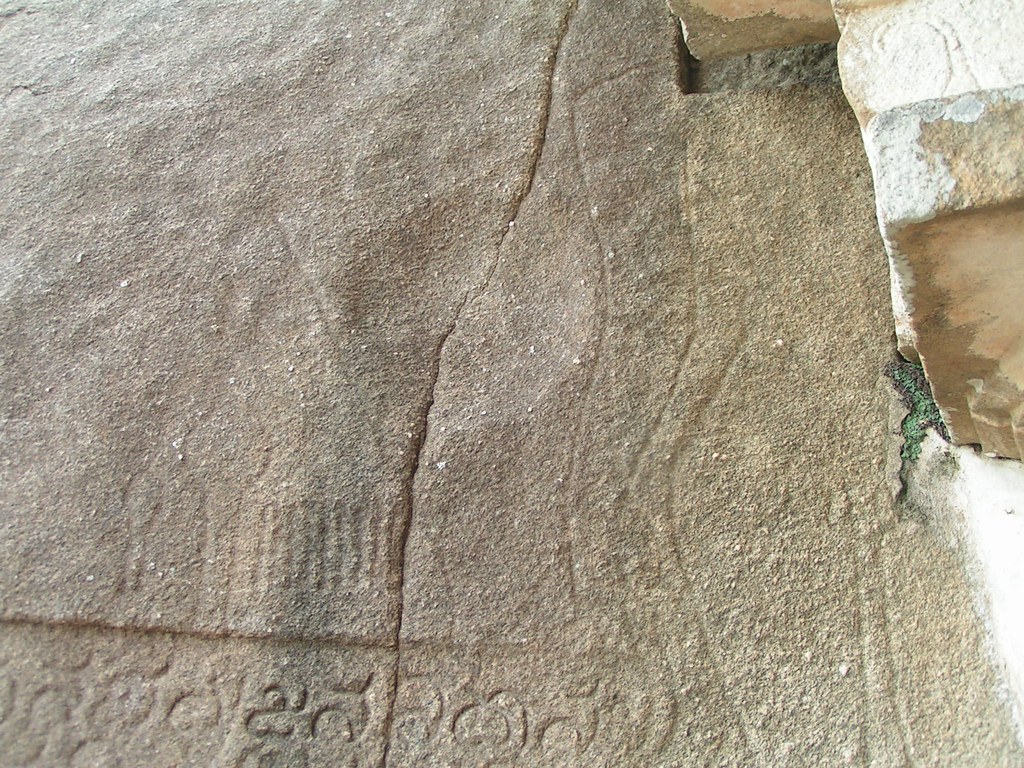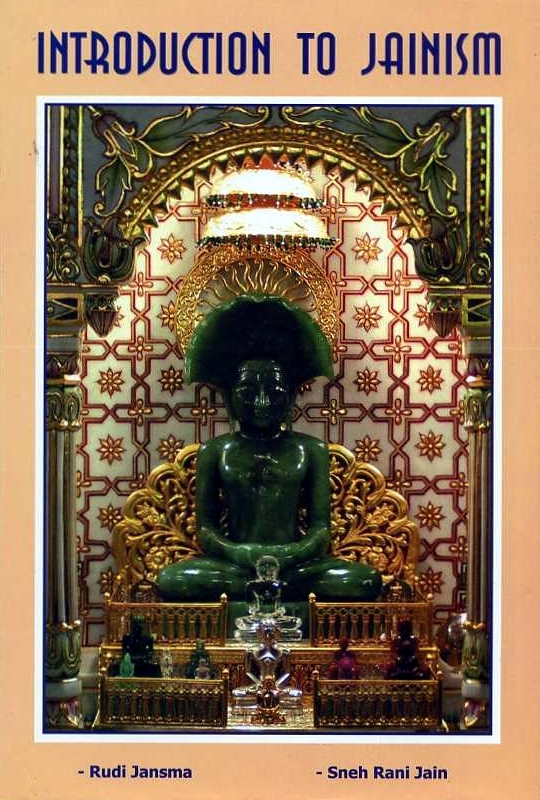The finding of four Indus scriptural signs together with a standing Jina on the South Indian Vindhyagiri at Śravana Belagola has shed much light on the Indus script (photo 10). The standing Jina is only partly visible, but his posture is very clear. His head and shoulders have been damaged by the roof of a later temple. On the remains of the floors and the steps of the original temple, which is much older than the Harappa period, some important Indus signs are visible. All these art works represent the first art historical period of art in the history of the Indus culture. In Śravana Belagola we see engravings measuring 90 to 120 cm, the largest ever found, and much larger than those described by R.S. Bisht at Kuttch on the Northern peninsula of Gujarat (West India, bordering Pakistan).
 Key Indus Rock of Karnataka; Vindhyagiri, Śravana Belagola
Key Indus Rock of Karnataka; Vindhyagiri, Śravana Belagola
photo 10
Key Indus Rock of Karnataka; Vindhyagiri, Śravana Belagola
 Indus script on Key Indus Rock of Karnataka; Vindhyagiri
Indus script on Key Indus Rock of Karnataka; Vindhyagiri
photo 11
Indus script on
Key Indus Rock of Karnataka; Vindhyagiri
The Indus signs of Śravana Belagola have much to say about the standing Jinas. The first of the four signs depicted here (photo 11) is a “spear,” which signifies in Jainism the self-control acquired by a Jina. The second sign is a “broom” of peacock feathers, which the monks used (and still use today) to softly brush aside living beings, which they otherwise might step on - a symbol of mahāvrata. Mahāvrata means the Great Vows an ascetic has taken. This sign is so big that the end stroke has been overwritten by a later text in old Kannada, an old script of Karnataka, which has been forgotten and can be read by no one today. Apparently the people who long ago added these Kannada writings to the rock even then had forgotten or did not understand the significance of the old signs. The third sign is a trident and symbolizes the ratnatraya - the threefold jewel of right vision, right knowledge and right conduct - which inspires the monk to perfection in their meditation. The awakened soul of the penitent thinks of nothing else than the eternal soul and liberation from all karmas by contemplating the seven “thatnesses” (tattvas) (the soul, karma, the inflow of karmas, the bondage by the karmas, the stopping of the inflow, the removal of karmas and final liberation), here represented by seven vertical lines. Thus the four Indus signs of Śravana Belagola together with the carved standing Jina convey a very deep philosophical Jain message for one who understands them and values the protection of his own soul. If we consider this text it appears that the Indus script is not a worldly language for everyday use, but serves a specific intellectual purpose. The profane world can not understand these signs because they are true hieroglyphs - sacred script - which can not be understood by those who do not know the higher ethics and teachings of Jainism. The rock was therefore given the name The Key Indus Rock of Karnataka. Such a valuable monument of human civilization is now being neglected, but that was very different 2500 years ago - one and a half centuries before the arrival of Emperor Chandragupta. This inscription in the Indus script thus contains three symbolic signs and a pictograph meant for Jain śramanas (ascetics) as guidance for the last moments of their lives. The same form of art was used to scratch the Indus signs into the granite rocks and told the life history of private monks. It was used at the beginning of the period in which humans learned to master the art of writing. From the viewpoint of art history we may regard this as the first phase, which came into being when writing implements were still nonexistent, but the desire to write was already strongly felt. The signs were merely used for religious purposes. In those days one was able to cut rough pillars, but no artistic refinement was possible in this hard stone. Climbing the rocks can not have been easy for the ascetics who lived in caves either, and once every two or three days they went down to collect food. In this manner the monks could live their austere lives away from the buzz of the world. The Greek Megasthenes, who followed the route of Alexander the Great in these days but went much further South than Alexander himself, kept a detailed diary of his observations. In his Indika he wrote in detail about their life and how they used to come down from the hills to the social world, and how the people had great respect for them and invited them into their homes to give them food. The only food the ascetics would accept was rice water. Various engraved markings in Indus style on the rocky surfaces of the Vindhyagiri in Śravana Belagola show that the rock had the function of a temple long before Bahabadru, the spiritual teacher of Emperor Chandragupta, arrived there.
 Rock carvings pointing towards manastambha and temple on Vindhyagiri
Rock carvings pointing towards manastambha and temple on Vindhyagiriphoto 12
Rock carvings pointing towards manastambha and temple on Vindhyagiri
On the bare rocks one sees large markings intended pilgrims pointing the way to the sacred shrines and locations on the rocks (photos 11 and 12). So both hills in Śravana Belagola show in fact a temple-like form of Indus art, with rock hills ending in a peak, and a Jina dedicated to penitence with lianas growing around their bodies to show how long they were standing motionless in their meditative posture.
South of Śravana Belagola too an Indus culture bloomed in the period long before Parśvanāth, who lived 2900 years ago, as is shown by engravings on various South Indian rock hills, with the seventh Tīrthamkara, Suparśvanāth, characterized by a hood of 5 snakeheads.
The findings in and around Harappa and Mohenjo-daro (now in Pakistan) in the first part of the twentieth century provided sensational information about these early forms of human civilization. Some experts estimate the antiquity of early Harappan culture at 7,000 years, the middle period at 5,500 and the later period at 4,000 years. The objects are numbered and stored in museums. So one now has texts available, and modern catalogues[88] contain detailed information. They show the seals and other objects which were studied later, notably by the Finnish researcher Asko Parpola,[89] the American G.L. Possehl,[90] and Iravatham Mahadevan[91] of India. Many others[92] have tried to decipher the script. Some claim partial success, but all give their own interpretation to the scriptural signs. Phonetic values have been assigned to them, but without the authors explaining what their assumptions are based on. The basis of transliteration by Indians has often been prejudiced and they have tried to explain the signs from a Vedic background (B.B. Lal, S.R. Rao) or to see the meter of the Hindu Gayātrī mantra or other suppositions reflected in them. Such claims have however recently been firmly rejected by leading scientists, particularly by Ram Sharan Sharma on a platform of the Indian Council of the Historical Research’s Foundation Day in March 2005. Sometimes more than one meaning is given to one sign, or one meaning to different signs. None of the researchers has considered the possibility that the signs could be read in a very different way, and could be approached from the mental perspective of the ancient Jains - the śramana tradition. The Indus scriptural signs could be far older than the alleged 7,000 years: there seem to be a number of seals, which show dinosaur-like creatures together with the script!
 Dr. Sneh Rani Jain
Dr. Sneh Rani Jain
 Publisher:
Publisher: